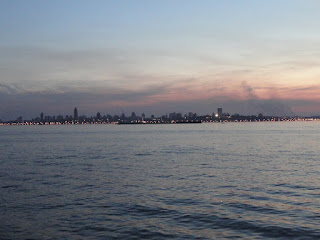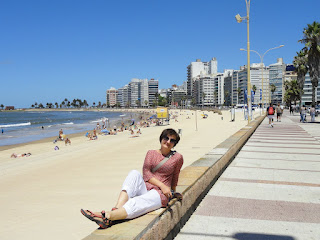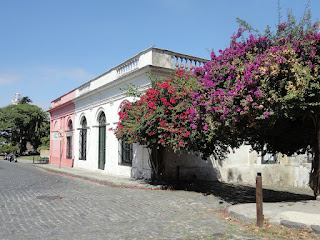 We have had quite a bit of waterfalls the past two days, so
instead of going to the Brazilian side of the falls today, we go to the Itaipu
Dam to the north of the town. We have
booked the Special Tour, which not only shows the outside of the dam, but also
the inside. It is a bit pricey, but this
is quite an amazing place.
We have had quite a bit of waterfalls the past two days, so
instead of going to the Brazilian side of the falls today, we go to the Itaipu
Dam to the north of the town. We have
booked the Special Tour, which not only shows the outside of the dam, but also
the inside. It is a bit pricey, but this
is quite an amazing place. The first interesting thing is that the area around the dam is sort of neither in Brazil or Paraguay but both countries. There are tonnes of facts about the size of it, it is 8km long, 200m high, the concrete poured into it every hour during construction would build a 22 story building, it generates nearly all of Paraguay’s electricity, and still it leaves it some to export to Brazil. It generates 20% of Brazils, and Brazil is a big place. Basically it holds the world record for generating electricity in a year, even though the Three Gorges Dam in China is bigger.
 Once you leave the visitor centre you are on a bus through a
sort of border post. The bus is
necessary because the distances are great, but they have great roads around the
dam so we are soon at the first viewing point, that of the spillway that
diverts the excess water. Today it is
only operating at about 1/3 capacity, but it is still channelling a greater
volume than the Iguacu falls. So much
for not seeing any waterfalls today.
After that there are two more viewing points, closer to the dam itself,
and then up on top of the dam, before we get to go into the dam. As a working power plant we need hard hats,
and it is hot and sticky, but it is cool.
Once you leave the visitor centre you are on a bus through a
sort of border post. The bus is
necessary because the distances are great, but they have great roads around the
dam so we are soon at the first viewing point, that of the spillway that
diverts the excess water. Today it is
only operating at about 1/3 capacity, but it is still channelling a greater
volume than the Iguacu falls. So much
for not seeing any waterfalls today.
After that there are two more viewing points, closer to the dam itself,
and then up on top of the dam, before we get to go into the dam. As a working power plant we need hard hats,
and it is hot and sticky, but it is cool.After that we head back to town and hang around for the rest of the day. It has to be said that Foz Do Iguacu is not the prettiest of towns, and it is a bit dead. But we do figure out how to eat for a lot less than the previous night, go to a pay per kilo place. Simply load up your plate from the buffet, get it weighed, and pay per kilo. I had a full plate of food for about £2.50 (only 336g, a kilo would cost about £8). A far better way to eat in Brazil.










































